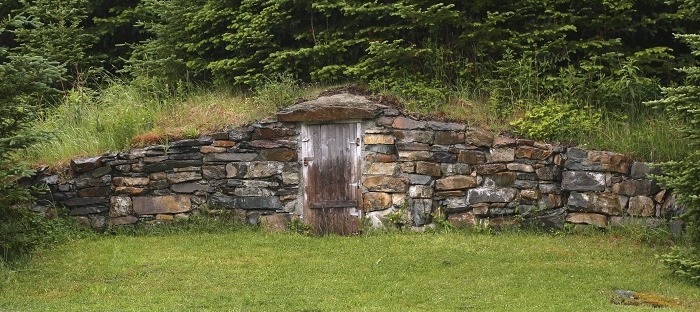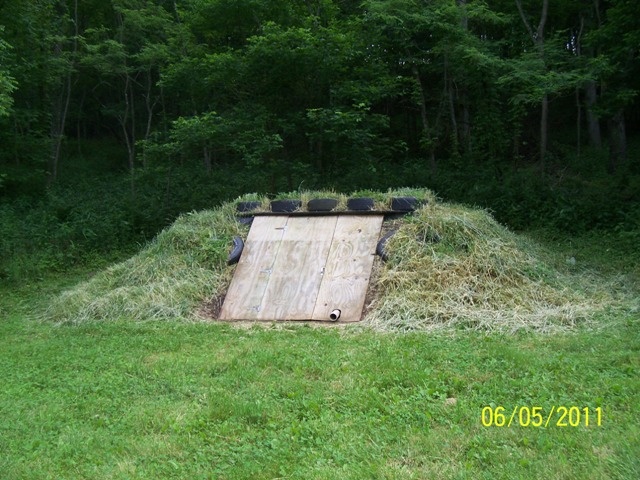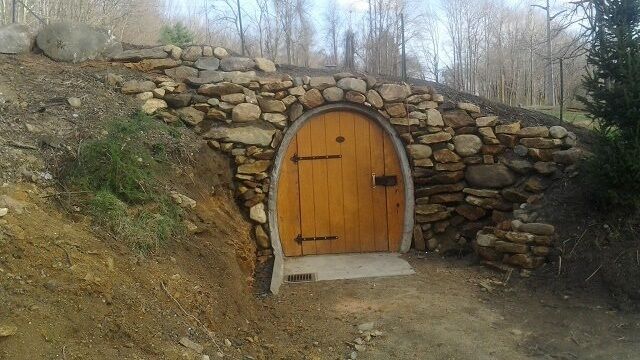It looks like you're using an Ad Blocker.
Please white-list or disable AboveTopSecret.com in your ad-blocking tool.
Thank you.
Some features of ATS will be disabled while you continue to use an ad-blocker.
22
share:
Im getting ready to be rotated out of work for a while.. and I may just resign because of *reasons*... so Im planning on doing some hardscaping this
year. I thought Id share some of the ideas, uses, and instructions for these permanent installations on your property. Even if you have a small yard
or are in the city, you CAN install something like this. You can even use the top of it as part of a garden. In my house I have a butlers pantry off
of the kitchen and a larger root cellar in the basement... but Im convinced you can never have enough literally squirreled away for a rainy day. If
you live in the right area you can use this basic design with a few small modifications as a spring house.. where the water from a spring comes into
the house and acts like a natural fridge even in the summer.
I personally tend to go overboard.. like my "decorative" pond. I hand dug a good sized pond in the back that was initially supposed to just be a little small drop in pond form pond. Nope.. it became large. My dogs swim in it and I throw fish in it I catch. So this MIGHT turn into a zombie apocalypse hidey hole / root cellar... or a prison for captured slaves to pull my chariot across the scorched wastelands during the great end of civilization after the Covid. You never know...



This is the culvert method.. concrete or steel culvert. Probably better for a fallout / root cellar and I like the idea!

The finished culvert root cellar looks more like a hobbit house.. which I suppose it could double as.

A few things first :
Be aware of ethylene gases from stored produce.
FRUITS AND VEGETABLES THAT MAY CREATE EXCESS ETHYLENE GAS INCLUDE:
Apples, apricots, avocados, ripening bananas, blueberries, cantaloupe, citrus fruit (not grapefruit), cranberries, figs, guavas, grapes, green onions, honeydew, ripe kiwi fruit, mangoes, melons, mushrooms, nectarines, okra, papayas, passion fruit, peaches, pears, peppers, persimmons, pineapple, plantains, plums, prunes, quinces, tomatoes and watermelon.
FRUITS AND VEGETABLES THAT MAY BE DAMAGED BY EXCESS
ETHYLENE GAS INCLUDE:
Asparagus, broccoli, Brussels sprouts, cabbage, carrots, cauliflower, chard, cucumbers, cut flowers, eggplant, endive, escarole, florist greens, green beans, kale, kiwi fruit, leafy greens, lettuce, parsley, peas, peppers, potatoes, potted plants, romaine lettuce spinach, squash, sweet potatoes, watercress and yams.
You need fresh air and circulation or you will get mold. It cant be a tightly sealed room.
You need humidity.. usually 80 to 95% for produce, but itll rust metals.. like canning lids. You can camphor( I use block camphor for insects AND to keep my tools unrusted) the lids but keep and eye and rotate stock.
You need darkness.. no light even though you need air movement. Light may make some things sprout and will ruin your produce.
Shelves.. they need to be wood and preferably cedar boards or posts at least. In my house I have a lot of cedar.. mainly support things and studs. It not only conducts heat less, it wards off many bugs and wont rust with the humidity being that high. Its also Du..dUN.. DUN!!! ANtibacterial.
Im basically trying to prevent as much loss as I can with these factors.
Here are much better worded instructions and things that I could ever do myself.. so take a look. Youll be shocked at how simple this is.. and how much it will reward you over the years. WHen I was a kid we had cellars and spring houses at different places I lived. Ive always loved them.. and I hope my grandkids will too. It was like a daydreamer type of kids paradise as I recall! I could also sneak a smoke from my dads pack in there. A root cellar is where I built my first homemade firework... with my dads powder and my grandmas denture tablet bottles. Nefarious plottings!
www.organized-home.com...
thehomesteadingboards.com...
commonsensehome.com...-gas
www.oldhouseweb.com...
www.backwoodshome.com...
www.fix.com...
www.shtfpreparedness.com...
I personally tend to go overboard.. like my "decorative" pond. I hand dug a good sized pond in the back that was initially supposed to just be a little small drop in pond form pond. Nope.. it became large. My dogs swim in it and I throw fish in it I catch. So this MIGHT turn into a zombie apocalypse hidey hole / root cellar... or a prison for captured slaves to pull my chariot across the scorched wastelands during the great end of civilization after the Covid. You never know...



This is the culvert method.. concrete or steel culvert. Probably better for a fallout / root cellar and I like the idea!

The finished culvert root cellar looks more like a hobbit house.. which I suppose it could double as.

A few things first :
Be aware of ethylene gases from stored produce.
FRUITS AND VEGETABLES THAT MAY CREATE EXCESS ETHYLENE GAS INCLUDE:
Apples, apricots, avocados, ripening bananas, blueberries, cantaloupe, citrus fruit (not grapefruit), cranberries, figs, guavas, grapes, green onions, honeydew, ripe kiwi fruit, mangoes, melons, mushrooms, nectarines, okra, papayas, passion fruit, peaches, pears, peppers, persimmons, pineapple, plantains, plums, prunes, quinces, tomatoes and watermelon.
FRUITS AND VEGETABLES THAT MAY BE DAMAGED BY EXCESS
ETHYLENE GAS INCLUDE:
Asparagus, broccoli, Brussels sprouts, cabbage, carrots, cauliflower, chard, cucumbers, cut flowers, eggplant, endive, escarole, florist greens, green beans, kale, kiwi fruit, leafy greens, lettuce, parsley, peas, peppers, potatoes, potted plants, romaine lettuce spinach, squash, sweet potatoes, watercress and yams.
You need fresh air and circulation or you will get mold. It cant be a tightly sealed room.
You need humidity.. usually 80 to 95% for produce, but itll rust metals.. like canning lids. You can camphor( I use block camphor for insects AND to keep my tools unrusted) the lids but keep and eye and rotate stock.
You need darkness.. no light even though you need air movement. Light may make some things sprout and will ruin your produce.
Shelves.. they need to be wood and preferably cedar boards or posts at least. In my house I have a lot of cedar.. mainly support things and studs. It not only conducts heat less, it wards off many bugs and wont rust with the humidity being that high. Its also Du..dUN.. DUN!!! ANtibacterial.
Im basically trying to prevent as much loss as I can with these factors.
Here are much better worded instructions and things that I could ever do myself.. so take a look. Youll be shocked at how simple this is.. and how much it will reward you over the years. WHen I was a kid we had cellars and spring houses at different places I lived. Ive always loved them.. and I hope my grandkids will too. It was like a daydreamer type of kids paradise as I recall! I could also sneak a smoke from my dads pack in there. A root cellar is where I built my first homemade firework... with my dads powder and my grandmas denture tablet bottles. Nefarious plottings!
www.organized-home.com...
thehomesteadingboards.com...
commonsensehome.com...-gas
www.oldhouseweb.com...
www.backwoodshome.com...
www.fix.com...
www.shtfpreparedness.com...
a reply to: Advantage
S&F for an excellent OP and topic!
I'm a self-sufficient kinda person so the first thing we did when we started building on the property was to make a spring house... we have two small streams so it was perfect for what we needed.
When we built the house a root cellar was a no-brainier because we wanted a basement.
For anyone that is wanting to build and use a root cellar, I would highly recommend the book "Root Cellaring" by Mike and Nancy Bubel.
There is a definite science to using a root cellar so know about it before you build it and it will save you heartaches afterwards.
Especially important is what you can grow in your area vs what you can store.
Having an orchard and fruit makes your setup entirely different than if you just wanted to store tubers, for instance.
Again, TY for starting this topic and I look forward to seeing who pitches in!!!
S&F for an excellent OP and topic!
I'm a self-sufficient kinda person so the first thing we did when we started building on the property was to make a spring house... we have two small streams so it was perfect for what we needed.
When we built the house a root cellar was a no-brainier because we wanted a basement.
For anyone that is wanting to build and use a root cellar, I would highly recommend the book "Root Cellaring" by Mike and Nancy Bubel.
There is a definite science to using a root cellar so know about it before you build it and it will save you heartaches afterwards.
Especially important is what you can grow in your area vs what you can store.
Having an orchard and fruit makes your setup entirely different than if you just wanted to store tubers, for instance.
Again, TY for starting this topic and I look forward to seeing who pitches in!!!
a reply to: Advantage
Nice.
I have always wanted to do mine with precast box culvert but it is expensive.
easternvault.net...
Nice.
I have always wanted to do mine with precast box culvert but it is expensive.
easternvault.net...
originally posted by: infolurker
a reply to: Advantage
Nice.
I have always wanted to do mine with precast box culvert but it is expensive.
easternvault.net...
Very cool! You could probably do similar with a shipping container. Youd have to weld a bit and seal a bit, but you could do it. Might be cheaper. You have to basically seal and reseal the concrete as well.. so I guess it would depend on which would require more materials.
originally posted by: Advantage
a reply to: Lumenari
Excellent!! Im going to look for the book
We have plums, apples, pears and berries of differnet kinds I planted maybe 10 years ago.. producing nicely but I have to battle the squirrels for a lot of it! LOL!
Some small things I have learned over the years...
Wet sand is your friend.
Ventilation is vitally important.
Potatoes and apples need to be put in different corners of the cellar!!!
If you are harvesting your own seeds with biennials (carrots, beets) and need to move them to the root cellar for the winter, cover them with canvas and leave them alone. No light at all on them during the winter.
Curing your tubers is important before storing them. (Especially potatoes!)
Wipe off your veggies before storing them... do NOT wash them.
And something that got me every time the first few years.... the term that one bad apple spoils the batch?
It's true.
So be CAREFUL on what you are putting up for the winter... a bruise on an apple may wipe out 100 later.
The first one reminds me of the one we used to have on our old farm. We put rutabagas in it for years, but the market for rutabagas fell out in the
winter, so we shoveled many of them out in the springtime. Not much money in Rutabagas back then, and we waxed hundreds of rutabagas every year,
throwing out half of them for maybe three years caused my dad to give up on growing more than fifty of them a year.
a reply to: Advantage
Yeah, current project that I am spending my money on is power. I already have a 60 panel grid tie solar set up so my power bill is just taxes and fees (about $20 a month).
I am planning a battery bank with associated hardware and bypass transfer switch to power my whole house if needed with the panels and battery.
Yeah, current project that I am spending my money on is power. I already have a 60 panel grid tie solar set up so my power bill is just taxes and fees (about $20 a month).
I am planning a battery bank with associated hardware and bypass transfer switch to power my whole house if needed with the panels and battery.
originally posted by: infolurker
a reply to: Advantage
Yeah, current project that I am spending my money on is power. I already have a 60 panel grid tie solar set up so my power bill is just taxes and fees (about $20 a month).
I am planning a battery bank with associated hardware and bypass transfer switch to power my whole house if needed with the panels and battery.
Now is the perfect time to make a thread about it... hint hint
originally posted by: rickymouse
The first one reminds me of the one we used to have on our old farm. We put rutabagas in it for years, but the market for rutabagas fell out in the winter, so we shoveled many of them out in the springtime. Not much money in Rutabagas back then, and we waxed hundreds of rutabagas every year, throwing out half of them for maybe three years caused my dad to give up on growing more than fifty of them a year.
Blargh.. rudabagas?? I dont grow them at all. I have no idea why they are gross to me, but I mustve eaten one once.
new topics
-
S.C. Jack Smith's Final Report Says Trump Leads a Major Conspiratorial Criminal Organization!.
Political Conspiracies: 1 hours ago -
Advice for any young Adult .
General Chit Chat: 2 hours ago -
Joe meant what he said about Hunter's pardon....
US Political Madness: 3 hours ago -
Regent Street in #London has been evacuated due to a “bomb threat.”
Other Current Events: 4 hours ago -
It’s Falling…
Philosophy and Metaphysics: 5 hours ago -
Steering the Titantic from the Drydock.
Rant: 8 hours ago
top topics
-
Steering the Titantic from the Drydock.
Rant: 8 hours ago, 10 flags -
Joe meant what he said about Hunter's pardon....
US Political Madness: 3 hours ago, 9 flags -
Paramilitary Leaks - John Williams
Whistle Blowers and Leaked Documents: 17 hours ago, 7 flags -
Advice for any young Adult .
General Chit Chat: 2 hours ago, 6 flags -
S.C. Jack Smith's Final Report Says Trump Leads a Major Conspiratorial Criminal Organization!.
Political Conspiracies: 1 hours ago, 6 flags -
It’s Falling…
Philosophy and Metaphysics: 5 hours ago, 4 flags -
Regent Street in #London has been evacuated due to a “bomb threat.”
Other Current Events: 4 hours ago, 3 flags
active topics
-
Los Angeles brush fires latest: 2 blazes threaten structures, prompt evacuations
Mainstream News • 27 • : Oldcarpy2 -
Judge rules president-elect Donald Trump must be sentenced in 'hush money' trial
US Political Madness • 67 • : Xtrozero -
Steering the Titantic from the Drydock.
Rant • 38 • : ElitePlebeian2 -
Advice for any young Adult .
General Chit Chat • 6 • : nerbot -
Labour Plotting to Postpone May's Council Elections ?
Regional Politics • 19 • : angelchemuel -
Paramilitary Leaks - John Williams
Whistle Blowers and Leaked Documents • 10 • : Kaiju666 -
S.C. Jack Smith's Final Report Says Trump Leads a Major Conspiratorial Criminal Organization!.
Political Conspiracies • 11 • : marg6043 -
House Passes Laken Riley Act
Mainstream News • 19 • : marg6043 -
Let's Buy Greenland
General Chit Chat • 19 • : network dude -
GOD may be ANGRY at CALIFORNIA for Becoming an ABORTION Mecca.
Conspiracies in Religions • 203 • : WeMustCare
22

